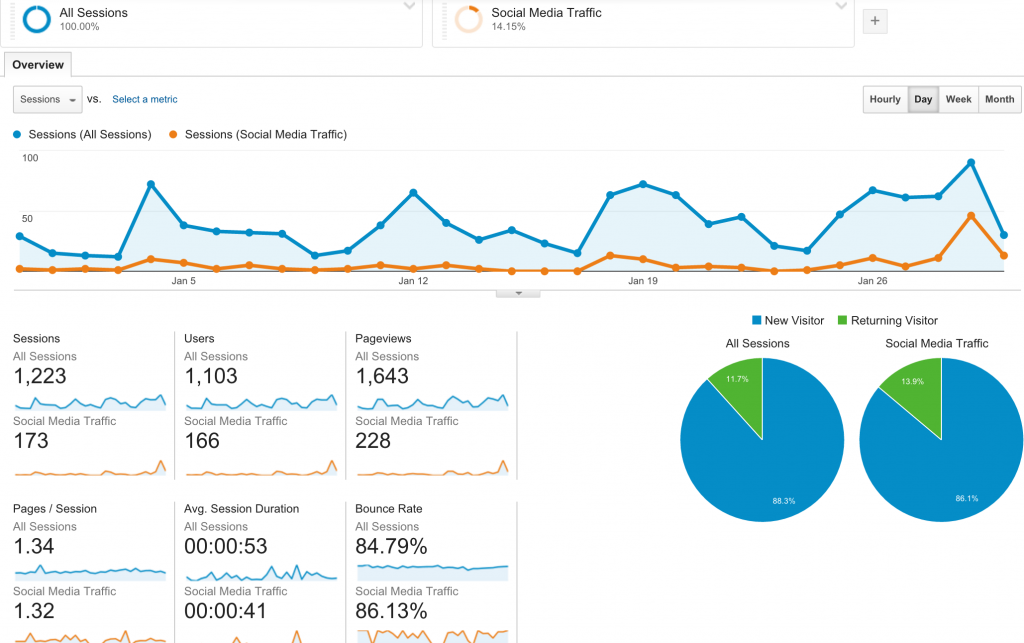
Most social media managers want to make a snazzy monthly, quarterly, or annual report to communicate the results of their program to the campus community. But, what should you include on the report?
Common metrics I’ve seen included are fan/follower counts, reach statistics, and engagement rates. While these are easy to access, I don’t believe they accurately portray the success of most programs. Metrics used to measure the success of a post or to evaluate a content strategy (i.e., reach and engagement rate) may be very different from the metrics used to measure the success of an entire program.
Proper success metrics should be tied to the goals of your social media program. So, if you haven’t thought about the purpose of your program, start there. In this post I propose three metrics that correspond to common goals of higher ed social media programs. You’ll see that they more closely tie to the program objective than any metric you could pull from Facebook, Twitter, or other social media platform analytics.
Measuring Website Referrals From Social Media
Program goal: use social media to increase traffic to your website
Success metric: percent of web visitors referred by social media
This is a metric you would get from Google Analytics (or another web analytics program). First, navigate to the report you’d like to view (perhaps All Traffic or Pages). Then, you’ll need to add a segment to get the number of users that came to your website from social media. Click “Add Segment” at the top of the report, filter by category social, and then choose the one that makes the most sense for you (I like “Social Media Traffic” by Rachel W.) Once you apply this segment, you’ll see two sets of numbers for each measurement in the report—one for all users, and one for users referred by social media. You can now report on the percent of web visitors referred by social media for your whole site, a single page, or a collection of pages.

Measuring Brand Health In Social Media
Program goal: support the university brand
Success metric: sentiment and share of voice
While “brand,” can be a bit of a nebulous term, it is often the responsibility of campus marketing and communications offices to define the brand, create on-brand messages, and monitor the health of the brand. When conducting these activities online, two metrics that are relevant are sentiment (the breakdown of mentions of your campus by positive/negative/neutral), and share of voice (the amount of online mentions of your campus in comparison to your identified competitors).
To accurately measure these metrics, you’ll likely need to invest in paid social media monitoring software. While the cost of these software packages vary, all of them I’ve reviewed can measure sentiment and share of voice out of the box. If you’d like to get a taste of this metric for free, follow the instructions provided by Jay Baer at Convince and Convert to use Social Mention and Excel to create a share of voice report that includes sentiment.
Measuring Customer Service Effectiveness In Social Media
Program goal: respond to inquiries from current and prospective students
Success metric: response rate and response time
Millennials expect to receive customer service on social media, and many campuses excel in this area. Proving that you respond to most of the social media mentions that come your way, and that you do so quickly, should be paramount in this instance. If your main tool is Facebook, the platform has evolved to provide these metrics to page administrators (at least for private messages), and pages that respond to 90% of messages in an average of 5 minutes or less can get a public “very responsive” designation.
While these metrics are helpful, they don’t include customer service provided on other networks, like Twitter. For that data, you’ll need to invest in a paid social media measurement or engagement tool. I’ve found that Sprout Social (which provides a discount to non-profit organizations) and Simply Measured do a pretty good job of measuring response time. But once again, these are paid tools.

Credit: SimplyMeasured
Conclusion
By using data sources other than the social media platforms themselves, you can report metrics that closely align with the objectives of your social media program. In some cases, this data is not free, but in my experience an investment in good software has been well worth it in order to effectively measure the effectiveness of the program I manage. What do you think? Will you be using any of these metrics in future reports?
Meet the Author: Dr. Liz Gross
Dr. Liz Gross is a graduate of the Higher Ed Experts Web Analytics certificate program. Higher Ed Experts is a professional online school for digital professionals working in universities and colleges.
When you take a professional certificate course with us, you get a chance to upgrade your skills by working on your projects, interacting with classmates just like you and getting detailed personalized feedback from your instructor.
Dr. Liz Gross is now the director of Campus Sonar, a social media listening consultancy.
Liz received her Ph.D. in Leadership for the Advancement of Learning and Service in Higher Education from Cardinal Stritch University. Her dissertation research examined the relationship between communication methods and the frequency and content of college student interactions with faculty.
She also taught for 2 years and half Higher Ed Expert’s 4-week online course on Social Media Measurement for Higher Education.
Tags: Higher Ed Marketing, Higher Ed Marketing Memos, Higher Ed News
3 Metrics To Measure The Success Of Your Higher Ed Social Media Program #highered #some https://t.co/f0cC6nKXGB
3 Metrics To Measure The Success Of Your Higher Ed Social Media Program via @BuzzSumo https://t.co/wwPu4uMmNZ https://t.co/MQigCYQt1D
RT @moffittk: 3 Metrics To Measure The Success Of Your Higher Ed Social Media Program via @BuzzSumo https://t.co/wwPu4uMmNZ https://t.co/MQ…
RT @moffittk: 3 Metrics To Measure The Success Of Your Higher Ed Social Media Program via @BuzzSumo https://t.co/wwPu4uMmNZ https://t.co/MQ…
Good read for #ismarketing folks: 3 Metrics To Measure The Success Of Your Higher Ed Social Media Program https://t.co/M2lem6o6nr
RT @peterdbaron Good read for #ismarketing folks: 3 Metrics To Measure The Success Of Your Higher Ed Social Media P… https://t.co/iEFlqqkI9D